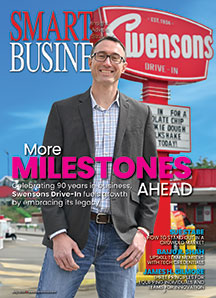It’s never easy admitting you’re wrong; try admitting your business is wrong.
But in business, it’s not enough just to say that your business plan is outdated or the service you provide is becoming obsolete. You have to act, and quickly.
Large corporations can’t do this. They are simply too expansive and too bureaucratic to rapidly change. But, they have access to the funds to stay afloat while the business model is analyzed, a strategic plan is developed, and finally, the model is revamped.
Smaller companies, however, have the luxury of starting again — to reinvent — if the entrepreneurs have the stomach for it.
“It’s one of the hardest things to do,” says Ronald Fountain, principal at turnaround firm The Parkland Group and former CFO of M.A. Hanna. “It’s like combining all the ingredients for brownies and trying to mix it a different way to come up with a pound cake.”
Consider the stories of Easy2 Technologies and Glazen Creative Group. The leaders of these companies, Easy2 founder John Bukovnik and Glazen founder Alan Glazen, saw their industries begin to change without them. The services they provided were either no longer profitable or no longer necessary to their customers.
At Easy2, Bukovnik launched a Web site with more than 100 tutorials to teach visitors everything from how to install a ceiling fan to how to correctly perform a golf swing. But in just a short time, the B2C e-commerce market dried up. Investors ignored the site. Advertising couldn’t cover the costs.
But there was a demand for Easy2’s lessons and technology, which Bukovnik is successfully licensing to other companies. He’s also designing custom lessons for other business clients.
Glazen’s reinvention wasn’t as rapid. Over several years, he saw his small ad agency slowly get squeezed out of projects by advertising conglomerates in New York and Chicago. He also witnessed companies building internal marketing staffs and doing away with many of the services smaller ad agencies offered.
Glazen reinvented his firm so it was no longer a simple ad agency but a multimedia production firm creating films, videos and commercials. Former competitors now come to Glazen for help.
These entrepreneurs could have quit, become consultants or gone corporate, but instead, they admitted their current business plan wasn’t working — despite how hard they’d worked on it. Instead of simply reacting to an immediate business threat, these entrepreneurs transformed the core of their businesses. The difference between the two reactions is like the difference between setting a clock and building one.
“Organizational change is a very difficult thing to accomplish,” Fountain says. “It is really only accomplished when there is a reason to change, when there is a capacity to change and when there is a willingness to change. And all three of those things have to be in place at the same time.”
Today, these firms are poised for even more growth. At the end of last year, Easy2 added Skil Tools, Rubbermaid and Coleman as clients. And Glazen, despite the economic downturn, says 2001 was his firm’s best year.
Bukovnik calls it “the most frustrating thing in the world” transforming his business from its original mission. No doubt it was.
But his and Glazen’s perseverance has paid off. Theirs are examples to follow, and we encourage you to read their stories.

